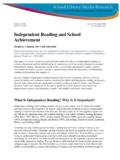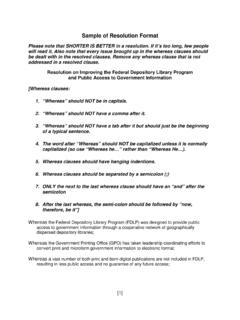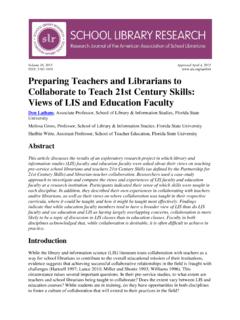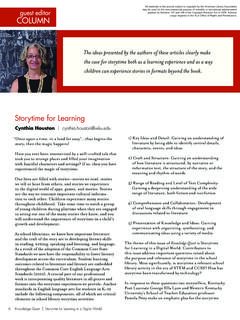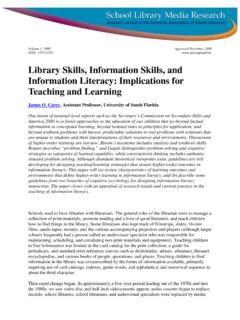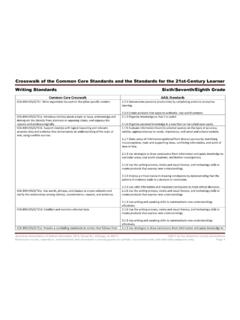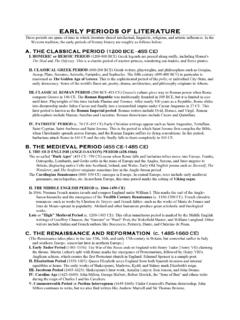Transcription of Organizational Culture and Organizational Change: How ...
1 Organizational Culture and Organizational Change: How Shared Values, Rituals, and Sagas can Facilitate Change in an Academic Library Jason Martin Organizational Culture is defined as the shared norms, may note the computers and quiet study rooms; facul- values, and beliefs of an academic library. Values are ty might mention ILL and the online journals; and li- the building blocks of Organizational Culture and brarians may point to the organization and collection are derived either from the organization's leaders or of scholarship. All of these descriptions are true, but from Organizational traditions with the latter making they are only part of what the library is. Any organiza- for stronger and more enduring values. The Culture tion is more than simply their mission statement and of a library expresses itself through symbols, sagas, services offered. Organizations are societies complete rites, and rituals. By understanding the Culture of a with their own values that dictate behavior and norms library, one gains an understanding of the underly- that provide a frame for members to interpret reality ing values and assumptions of the organization and (Morgan 1997).
2 In other words, all organizations, no what motivates and drives the behavior of those matter their type, grow and nurture their own Culture , within the library. Change in an organization cre- an Organizational Culture . ates uncertainty in an organization. This uncertainty Culture is an en vogue term in much leadership creates fear among those in the organization making literature of the day, but the phrase is usually given change management very difficult. Building change superficial treatment. When an Organizational leader on and around the core values of the library's Culture speaks of the need to develop a Culture of sustain- makes implementing the change less uncertain and ability or a Culture of ethics, this is not the same as unpredictable thereby making the librarians and li- the deep, complex concept of Organizational Culture . brary staff less stressed and fearful. Emphasizing an Organizational members tacitly understand their own organization's values, especially how the change will Culture but usually can not convey verbally what their enhance those values, strikes at the very heart of those Culture is and what it means; they just understand how within the organization and makes them more open things are done.
3 Through shared values, heroes and to and accepting of change. heroines, rituals and ceremonies, and a cultural net- work Organizational Culture creates a sense of iden- Organizational Culture tity, community, and sense of belonging amongst its When asked to describe the library, different groups members (Deal and Kennedy 1983 and Jordan 2003). on campus will respond in different ways. Students Culture provides meaning to the work of the organi- Jason Martin is Head of Public Services at duPont-Ball Library, Stetson University; e-Mail: 460. Organizational Culture and Organizational Change 461. zation by allowing members to be part of something part of any Organizational Culture as all cultures are larger than themselves, ensures members abide by or- composed of symbols. A rite or ritual has a manifest ganizational norms, and frames the outside world so purpose in the normal day-to-day operations of the its members can more easily interpret reality (Smir- organization, but they also fulfill a latent or symbol- cich 1983).
4 Culture provides sustainability to an orga- ic role by reinforcing the values of the organization nization and maintains social cohesion and solidarity through the active participation of its members. Sagas amongst those in the organization (Cartwright and are Organizational histories that blend fact and fiction Baron 2002). An organization's effectiveness is influ- to explain the current beliefs and norms of a Culture . enced, either directly or indirectly, by its Culture and Sagas often arise from an organization in chaos and the prevailing mindset and overall happiness it engen- tell how the members banded together to save and ders amongst the organization's employees (Gregory advance the organization. Sagas are crucial to under- et al. 2009). standing an Organizational Culture as they provide a Organizational Culture emerges from the exter- glimpse into the past. nal environment, history, and day-to-day operations of the organization. The interactions of the organiza- Organizational Change tion and its members shapes and molds the Culture as Efforts to initiate change in organizations are largely does the longevity of the organization, the richness of unsuccessful (Higgs and Rowland 2010).
5 Change is its shared history, how well Culture is taught to new complex and failure can occur at many levels. Change members, and the values and beliefs of its founders. agents can bring about their own downfall through a An organization without a long history, strong found- lack of communication and the mismanagement of ing values, or steadfast personnel will have a weak cul- employee trust (Ford, Ford, and D'Amelio 2008) or by ture (Schein 1990). Values are the foundation of or- trying to undertake too much change at once. Most ganizational Culture and are the strongest when they change efforts, however, are unsuccessful because of have stood firm over the course of an organization's resistance, either active or passive, of those within the history. No matter how well meaning, values imposed organization. People resist change for a variety of rea- from the top of an organization are the weakest ones sons. Employees may actively work against a change in an organization.
6 Initiative because they feel they have no stake in the The old guard, seasoned members of the Culture , change process, do not want to take on the increased teach the Culture to new members. Teaching organi- work change creates, are concerned about their lack zational Culture begins with the hiring process and is of needed skills to thrive in the organization after carried on in a plethora of ways, both formal and in- the change, or are worried they might lose their jobs formal, including training workshops, HR programs, (Kanter 2012). Change means the elimination of the employee stories, and ceremonies (Goffee and Jones status quo causing individuals and groups to lose 1998 and Schein 1990). How well new members learn their power in an organization. These employees will the Culture determines the future strength of the cul- work against change to ensure they keep their power. ture. The Culture becomes stronger when it is learned Mostly change creates uncertainty, and people orga- and accepted completely, and weakens over time nize their lives in such a way so as to maximize their when newcomers are only partially taught the orga- day-to-day consistency.
7 A large amount of congruity nization's Culture . allows one to see life as orderly, predictable, familiar, Organizational Culture is expressed through cul- and safe (Bailey and Raelin 2010). Change makes life tural artifacts like symbols, rites and rituals, and sa- seem less safe and orderly, thereby causing those un- gas. Jordan (2003) defines a symbol as any object that dergoing change to feel threatened. represents another object which holds a deep mean- The literature is filled with tips and advice on ing for the Culture 's members. Librarians value books how to manage change and overcome or diffuse re- because they are symbolic of information, and access sistance. Some of the most familiar methods include to information is a deeply held value in librarianship. implementing change slowly, understanding the rea- A symbol can take any number of forms other than sons behind employee resistance, engaging everyone the physical including logos, slogans, and images.
8 Jor- in the organization, instituting a system of incentives dan (2003) argues symbols are the most important and punishment, and personnel turnover (Hansen April 10 13, 2013, Indianapolis, IN. 462 Jason Martin 2012 and Askenas 2011 and Musselwhite and Plouffe deeper and stronger. By strengthening the values, the 2011). Of course leadership plays a large role in the change agent is making the Culture more robust. Fur- level of resistance and the success of change. Lead- ther, since values are the foundation of Organizational ers who are act as role models during change, play Culture , a Culture 's members hold its values dear. By a visible role in the change effort, and communicate linking the change to strengthened values, members honestly and completely are often more successful at are more likely to be accepting of the change. Change managing change (Musselwhite and Plouffe 2011 and should also be linked to the positive future of the orga- Merrell 2012).
9 Nization. Those members who are deeply committed Decreasing resistance to change is important be- to the Culture of the organization are also deeply com- cause the attitudes of those within the organization mitted to the organization itself. By emphasizing the greatly influence the success of a change project. Two growth and sustainability of the organization, employ- kinds of commitment to change exist: affective com- ees' normative commitment is strengthened. mitment and normative commitment. Affective The sagas of a Culture are also particularly valu- commitment is tied to the employee's perception of able during change. Most sagas start with the organi- how beneficial the change will be, usually to the em- zation in chaos and tell how it overcame obstacles and ployee. The foundation from normative commitment bested competitors. The heroes of the past can be used comes from the sense of obligation an employee has to illuminate the path of the future.
10 Emphasizing how to the organization. Normative commitment is more the organization has overcome greater difficulties in strongly associated with positive attitudes for change, the past gives resolve to those in the present situation. meaning an organization with high normative com- Those who are still in the organization who helped mitment is much likelier to experience successful overcome great difficulties in the past can be held aloft change (Shin, Taylor, and Seo 2012). Other studies as heroes in the organization who can provide sup- have shown a strong fit between employee and orga- port, comfort, and advice. Rites and rituals also play a nization can lead to stronger commitment by and crucial role in Organizational change. Rituals perform higher retention of employees during change (Meyer, two crucial tasks: provide certainty and allow for cele- Hecht, Gill, and Toplonytsky 2010). An Organizational bration. As was discussed earlier, resistance to change leader and change agent are able to foster higher lev- comes about in large part because of the uncertainty els of normative commitment and better fit between change creates.
